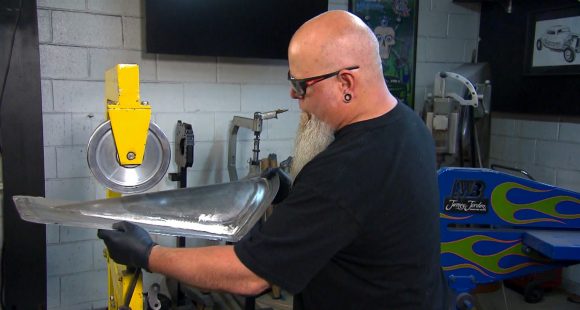Custom Sheet Metal
We all know that, with time, steel sheet metal rusts and rots, another way classic cars are literally disappearing. Likewise, custom metal fabrication is a vanishing art, but our Dan Maffett took us to a shop keeping this medium alive on MotorWeek’s “Your Drive!”
DAN MAFFETT: No matter what year your classic car is, it was built on an assembly line and assembled by a team of craftsmen. The bodies were fabricated by a team of coachbuilders. Now, coachbuilding is a dying art, but there’s a few fabricators across the U.S. that are keeping that art alive. I’m here with Butch Lloyd of Lloyd’s Originals, and he’s doing just that. Butch, thanks for having us. Tell us what you do here.
BUTCH LLOYD: So, mostly I do metal fabrication, um, customizing the car when a customer wants to change it, make it unique. I usually do that for them. Also, we take stock replacement panels and make them fit the car. A lot of times, they don’t fit correctly right out the box, so with a little tweaking, we can make them look like they belong on the car.
DAN MAFFETT: But with modern coachbuilding like you do, you can take a piece of a car that was never there, and make it fit an older car or a different vehicle, something like this that you were telling me about.

BUTCH LLYOD: These are ’55 Cadillac fender tops. The idea with this car, the stock headlights had no eyebrow. I wanted to add an eyebrow to the headlight. A lot of people use a ’56 Chevy. I wanted to do something a little different, so I found a ’55 Cadillac. They surprisingly fit really well.
DAN MAFFETT: They look incredible, yeah.
BUTCH LLYOD: With a little bit of slicing and dicing, the hardest area was right here in the front corner, you can make them work. The idea is to make it look like it should have been there.
DAN MAFFETT: Like it could have come from factory this way.
BUTCH LLYOD: Yeah, so you don’t want it to look like an afterthought or an add-on piece. You want it to look like it belongs.
DAN MAFFETT: Now, I know they don’t make they don’t make patch panels or reproduction panels for every car. Looking at this, I see there’s a whole new firewall panel in here with sharpie on it. Is that something you’re making from scratch?
BUTCH LLYOD: Yes, so in this car, because of the motor and the carburetor setup, I wanted to have a nice reveal behind the motor. So, I take a flat piece of sheet metal, Cleco it into the car, then shape it around it, use the sharpie to kind of lay out the design that I want it to be. This particular firewall, the sharpie will be put into the pull-max and will be pressed to have a– probably a half-inch relief, so that it will be pockets where all the squares are.
DAN MAFFETT: So the pull-max is one of those tools you kind of can’t live without?
BUTCH LLYOD: Yes, yes, it definitely allows you to make a lot more panels.
DAN MAFFETT: What other tools do you use that you kind of couldn’t do this job without?
BUTCH LLYOD: Definitely need an English wheel, planishing hammer and, for me personally, my welder.
DAN MAFFETT: Yeah, the welder seems like that’s the piece that ties everything together.
BUTCH LLYOD: Yeah, without the welder I couldn’t do any of this, so…
DAN MAFFETT: That’s fantastic. Do you use a lot of bead rollers as well?
BUTCH LLYOD: Yes, bead roller, you can make some pretty cool designs, and also shape some panels with it as well. It’s definitely a tool in the arsenal.
DAN MAFFETT: Thanks for having us. As always, any questions or comments, hit us up right here at MotorWeek.














